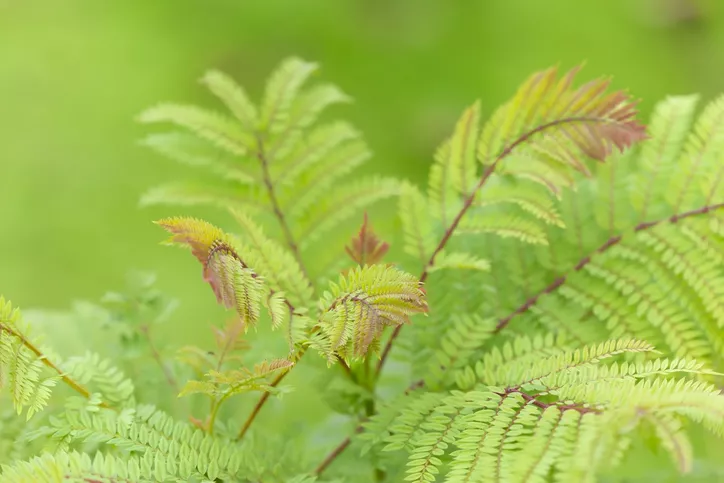- The Jacaranda tree comes from the tropics of South America
- A good location for the jacaranda bonsai
- Cut jacaranda as bonsai
- How to properly wire the rosewood tree
- Proper care of jacaranda as a bonsai
- Water and fertilize jacaranda as bonsai
- This is how you repot
- Identify pests and treat them immediately
- Jacaranda overwinter frost-free
The jacaranda tree is also very popular as a bonsai because of its good pruning tolerance, although it does not develop its impressive flowers in indoor culture. What you need to consider when pruning, wiring and caring for a jacaranda as a bonsai.
 The Jacaranda makes a very beautiful bonsai
The Jacaranda makes a very beautiful bonsai
The Jacaranda tree comes from the tropics of South America
The jacaranda comes from the subtropics and is therefore used to warm climates. It does not tolerate any frost and needs relatively high temperatures even in winter.
The decorative flowers do not appear in indoor culture and when kept as a bonsai. Only when the tree has reached a certain height can it develop inflorescences.
Therefore, the jacaranda is grown as a bonsai mainly because of its pinnate leaves.
A good location for the jacaranda bonsai
The location of the jacaranda must be as bright as possible. However, he does not like direct sunlight that much. If it stands outside in summer, it needs a place that is sheltered from the wind.
The temperatures at the location of the rosewood tree should be between 20 and 25 degrees in summer. In winter they must not fall below 14 degrees.
Cut jacaranda as bonsai
The Jacaranda tolerates pruning very well. The woodland and solitaire styles come into question as bonsai forms.
The jacaranda is cut every six to eight weeks. Pruning will begin in May. From October you may no longer cut the tree.
In addition to the branches and twigs, the roots are also trimmed when repotting. This is the only way to achieve a pleasant appearance of the Jacaranda tree.
How to properly wire the rosewood tree
The branches of the jacaranda can be shaped very well by wire. The shoots and the trunk are wrapped with wire in a spiral, always from bottom to top. The wire should be neither too loose nor too tight.
Since the branches, twigs and trunk begin to grow in thickness in May, you should remove the wire now to prevent unsightly wire marks.
Proper care of jacaranda as a bonsai
- Water regularly
- fertilize
- repot
- to cut
- hibernate
Water and fertilize jacaranda as bonsai
In order to care for the jacaranda as a bonsai, you must attach particular importance to the correct watering and fertilizing.
The root ball should never dry out completely. However, waterlogging is just as harmful. Always water when the top layer of the substrate has dried. Do not leave any water in the saucer or planter. Use stale, warm tap water for watering, or preferably rainwater that is not too cool.
The jacaranda is fertilized from spring to autumn. Suitable fertilizers are liquid fertilizers or fertilizer cones for bonsai on an organic basis. Apply the fertilizer according to the instructions on the package. In winter and after repotting, stop fertilizing the jacaranda.
This is how you repot
When caring for a bonsai, you should repot the jacaranda at least every two years. This is not only important because of the pot size, because a new bowl is only necessary when the root ball pushes out at the top. Changing the plant substrate also ensures that the plant stays healthy. Spring is the best time to repot when you get the jacaranda out of winter quarters.
Take the jacaranda out of the old pot and shake off the old substrate. Prune the roots to improve branching and keep the tree small.
Bonsai soil from the garden store is suitable as a plant substrate. You can also mix the substrate yourself from one third each:
- Akadama
- humus
- lava chippings
Identify pests and treat them immediately
The Jacaranda is quite hardy if you take care of it properly. Occasional whitefly or spider mite infestations may occur.
You can recognize whiteflies by the winged pests that can be found on the underside of the leaves. Spider mites are barely visible to the naked eye. Spray the jacaranda leaves with water. If there are small webs in the leaf axils, this is a sign of spider mites.
You should treat an infestation by pests immediately to prevent them from spreading. Rinse the jacaranda in the shower to remove the pests. Cover the ground while doing so. Use commercially available pesticides that you put into the ground.
Jacaranda overwinter frost-free
The jacaranda is not hardy. It must be overwintered frost-free and even quite warm. The ideal temperatures in winter are between 17 and 19 degrees. It shouldn't be colder than ten degrees.
The winter location should be as bright as possible. Watering is very sparse in winter, so do not fertilize at all during this time.
tips
In winter, the jacaranda usually does not get enough light. He then discards his leaves. But that is not a problem, as the leaves will sprout again when it gets more light from spring.